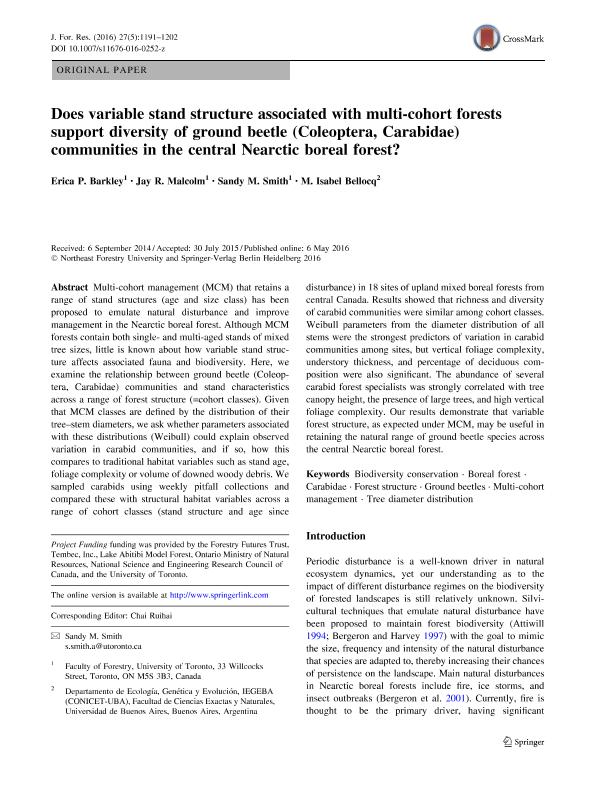Mostrar el registro sencillo del ítem
dc.contributor.author
Barkley, Erica P.
dc.contributor.author
Malcolm, Jay R.
dc.contributor.author
Smith, Sandy M.
dc.contributor.author
Bellocq, Maria Isabel

dc.date.available
2018-10-01T17:54:35Z
dc.date.issued
2016-10
dc.identifier.citation
Barkley, Erica P.; Malcolm, Jay R.; Smith, Sandy M.; Bellocq, Maria Isabel; Does variable stand structure associated with multi-cohort forests support diversity of ground beetle (Coleoptera, Carabidae) communities in the central Nearctic boreal forest?; Springer; Journal of Forestry Research; 27; 5; 10-2016; 1191-1202
dc.identifier.issn
1007-662X
dc.identifier.uri
http://hdl.handle.net/11336/61388
dc.description.abstract
Multi-cohort management (MCM) that retains a range of stand structures (age and size class) has been proposed to emulate natural disturbance and improve management in the Nearctic boreal forest. Although MCM forests contain both single- and multi-aged stands of mixed tree sizes, little is known about how variable stand structure affects associated fauna and biodiversity. Here, we examine the relationship between ground beetle (Coleoptera, Carabidae) communities and stand characteristics across a range of forest structure (=cohort classes). Given that MCM classes are defined by the distribution of their tree–stem diameters, we ask whether parameters associated with these distributions (Weibull) could explain observed variation in carabid communities, and if so, how this compares to traditional habitat variables such as stand age, foliage complexity or volume of downed woody debris. We sampled carabids using weekly pitfall collections and compared these with structural habitat variables across a range of cohort classes (stand structure and age since disturbance) in 18 sites of upland mixed boreal forests from central Canada. Results showed that richness and diversity of carabid communities were similar among cohort classes. Weibull parameters from the diameter distribution of all stems were the strongest predictors of variation in carabid communities among sites, but vertical foliage complexity, understory thickness, and percentage of deciduous composition were also significant. The abundance of several carabid forest specialists was strongly correlated with tree canopy height, the presence of large trees, and high vertical foliage complexity. Our results demonstrate that variable forest structure, as expected under MCM, may be useful in retaining the natural range of ground beetle species across the central Nearctic boreal forest.
dc.format
application/pdf
dc.language.iso
eng
dc.publisher
Springer

dc.rights
info:eu-repo/semantics/openAccess
dc.rights.uri
https://creativecommons.org/licenses/by-nc-sa/2.5/ar/
dc.subject
Biodiversity Conservation
dc.subject
Boreal Forest
dc.subject
Carabidae
dc.subject
Forest Structure
dc.subject
Ground Beetles
dc.subject
Multi-Cohort Management
dc.subject
Tree Diameter Distribution
dc.subject.classification
Otras Ciencias Biológicas

dc.subject.classification
Ciencias Biológicas

dc.subject.classification
CIENCIAS NATURALES Y EXACTAS

dc.title
Does variable stand structure associated with multi-cohort forests support diversity of ground beetle (Coleoptera, Carabidae) communities in the central Nearctic boreal forest?
dc.type
info:eu-repo/semantics/article
dc.type
info:ar-repo/semantics/artículo
dc.type
info:eu-repo/semantics/publishedVersion
dc.date.updated
2018-10-01T16:09:17Z
dc.identifier.eissn
1993-0607
dc.journal.volume
27
dc.journal.number
5
dc.journal.pagination
1191-1202
dc.journal.pais
Alemania

dc.journal.ciudad
Berlin
dc.description.fil
Fil: Barkley, Erica P.. University of Toronto; Canadá
dc.description.fil
Fil: Malcolm, Jay R.. University of Toronto; Canadá
dc.description.fil
Fil: Smith, Sandy M.. University of Toronto; Canadá
dc.description.fil
Fil: Bellocq, Maria Isabel. Consejo Nacional de Investigaciones Científicas y Técnicas. Oficina de Coordinación Administrativa Ciudad Universitaria. Instituto de Ecología, Genética y Evolución de Buenos Aires. Universidad de Buenos Aires. Facultad de Ciencias Exactas y Naturales. Instituto de Ecología, Genética y Evolución de Buenos Aires; Argentina
dc.journal.title
Journal of Forestry Research
dc.relation.alternativeid
info:eu-repo/semantics/altIdentifier/doi/http://dx.doi.org/10.1007/s11676-016-0252-z
dc.relation.alternativeid
info:eu-repo/semantics/altIdentifier/url/https://link.springer.com/article/10.1007%2Fs11676-016-0252-z
Archivos asociados
